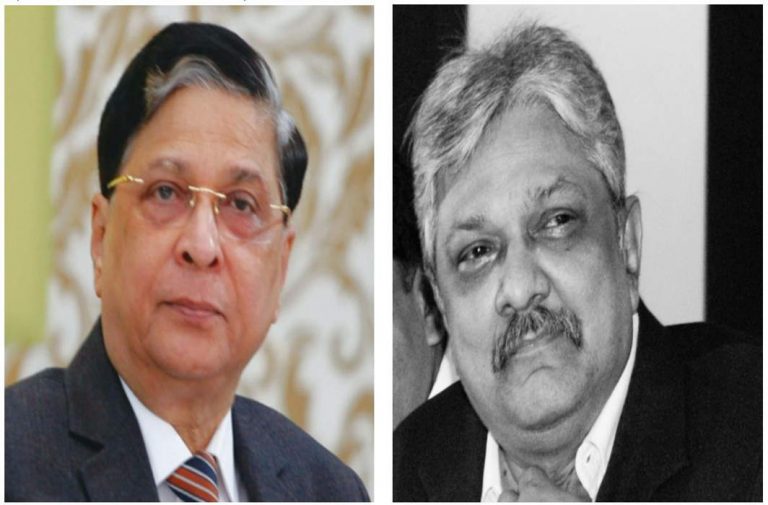
CJI Dipak Misra (left) and Justice KM Joseph
~By Vinay Vats
The elevation of one name amongst two names recommended by the collegiums has invoked many questions on the independence of the Judiciary. It also questions the powers of the collegiums of the Supreme Court and its supremacy.
Reacting to this, many senior advocates and politicians have expressed their displeasure against this move. Former Finance Minister p Chidambaram tweeted 2 tweets,
- “What is holding up Justice K M Joseph’s appointment? His State or his religion or his judgement in the Uttarakhand case?”
- “As the law stands now, the recommendation of the SC collegium is final and binding in the appointment of judges. Is the Modi government above the law?”
Meanwhile, former Chief Justice of India T S Thakur commented that this kind of response of turning down collegiums recommendation only because of an adverse order by the respective judge will give out wrong message to others that if you will give a decision against the government then there will be consequences. Former CJI Lodha had stressed that “the Chief Justice cannot sit over the file either, indefinitely, as can’t the government”.
Many top opposition leaders allege that the stand taken by the government is because Justice Joseph had strike down the President Rule in the state of Uttarakhand in 2016.
The three reasons given by the government for withholding the Supreme Court collegium’s recommendation to elevate Uttarakhand Chief Justice K M Joseph are
- Seniority
- Regional representation and
- Absence of SC/ST judges
SENIORITY
As far as seniority is concerned, there have been several instances in the history where a junior judge was elevated to Supreme Court judges withholding a senior judge and hence the argument of government on that ground has no tooth.
For example, Hon’ble Mr. Justice S. Abdul Nazeer from the Karnataka High Court became the first judge in last twenty years who was elevated to the Supreme Court judge without being elevated as a Chief Justice of any High Court. Although elevating a Chief Justice of High Court to Supreme Court judge is conventional practice but not a law. At that time also, Justice Nazeer superseded two senior judges and was appointed as Supreme Court Judge. Same case was also with Hon’ble Mr. Justice Mohan M. Shantanagoudar who was not the senior most in the list of seniority while getting elevated to Supreme Court. In the case Hon’ble Mr. Justice L. Nageswara Rao and Hon’ble Mr. Justice Uday Umesh Lalit, they were directly elevated as a Supreme Court judge and never served as judge or chief justice of any high court. Even Justice K M Joseph is having more experience as Chief Justice than few sitting Supreme Court judges like Hon’ble Mr. Justice Mohan M. Shantanagoudar and Hon’ble Mr. Justice Deepak Gupta.
The next Chief Justice of India Hon’ble Mr. Justice Ranjan Gogoi was elevated as Supreme Court judge superseding Hon’ble Mr. Justice Madan Bhimarao Lokur, Hon’ble Mr. Justice Kurian Joseph and Hon’ble Mr. Justice Arjan Kumar Sikri.
Hence the argument raised by the government on the basis of seniority is very dubious in nature.
REGIONAL REPRESENTATION
The next argument raised by the government against the elevation of Justice K M Joseph is that Kerala is already adequately represented in the Supreme Court as Hon’ble Mr. Justice Kurian Joseph is from Kerala. Government also argued that Kerala is adequately represented as the Chief Justices of High Court. However it is matter of fact that Uttarakhand, Kerala and Chhattisgarh have judges from Kerala but can it act as a ground for non elevation of a Judge to Supreme Court? That is a question to ponder upon. Kerala is not the only state being adequately represented in the Supreme Court. There are six High Courts which have more than one representative as a Judge in Supreme Court. Presently, three judges in the Supreme Court are from Bombay, and 2 judges each are from Karnataka, Madhya Pradesh, Andhra Pradesh, Allahabad and Delhi.
Hence the issue of regional representation is also a futile argument raised by the government of India.
ABSENCE OF SC/ST JUDGES
As far as SC/ST representation is concerned, it is a matter of fact that Former Chief Justice of India K G Balakrishnan was the only Chief Justice of India belonging to this community and no other Dalit has served as a Supreme Court judge after his retirement. But the issue is, approved strength of Supreme Court is 31. Presently, after appointment of Senior Advocate Indu Malhotra as Supreme Court Judge, strength of Supreme Court is 25. There is still a vacancy of 6 judges. Further, 6 Judges are due to retire in Supreme Court in 2018, after which the vacancy will go upto 11. Is government trying to imply that they are going to appoint Judges belonging to only this community from now onwards?
Government might be under the impression that they have given a very proper reply against the non elevation of Justice K M Joseph but they forget to analyze the absurdity of these arguments. However, Collegium meeting is to take place on 2 May, 2018 and every citizen’s eye is on the outcome of the meeting and further stand of the Government but it will be interesting see in the coming future that how government make further appointment in the supreme court on the basis of the arguments raised by them in the present case.

